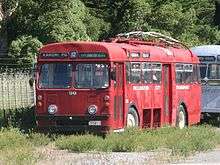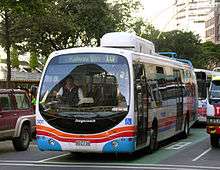Trolleybuses in Wellington
 A new trolleybus at Wellington Railway Station. | |||||||||||||||||
| Operation | |||||||||||||||||
|---|---|---|---|---|---|---|---|---|---|---|---|---|---|---|---|---|---|
| Locale | Wellington, New Zealand | ||||||||||||||||
| |||||||||||||||||
| |||||||||||||||||
Trolleybuses in Wellington have been part of the Wellington public transport system since 1949. They are the only trolleybuses operating commercially in Oceania and the last major system operating in a country that drives on the left.
History


The first route operated between 1924 and 1932.[1] It used a single AEC 602, and ran from Thorndon along Hutt Road to Kaiwharawhara.
A trolleybus was chosen over an extension to the Wellington tramway system because a large watermain on the route precluded tram track construction. The service was replaced with diesel buses.
A second and more extensive network was approved in 1945, when it was decided to gradually replace trams with trolleybuses, preferred for being more manoeuvrable and "more modern", and preferred over diesel or petrol buses due to better traction on steep slopes.[1]
At its maximum extent the network stretched for around 50 kilometres[1] – in addition to current services, trolleybuses went to Oriental Bay, Northland and Wadestown,[2] and routes in the central city were more extensive.

The fleet peaked at 119 vehicles, including Crossley Dominion, British United Traction RETB1 (in various forms) and Volvo B10M and B58 models.
In 2007 a new fleet of 60 new trolleybuses were built by DesignLine, in Ashburton, using some components from the previous fleet. They have a greater passenger capacity than previous trolleybuses, are low-floor and incorporate other improvements – they are expected to de-wire less frequently, and the 57 three-axle models are able to operate for short distances off-wire from batteries. The electrical equipment was provided by Eletra Industrial, from Brazil.
Delivery began in late 2007[3] and finished in 2009.[4]
The network has been threatened with closure over the years, mainly on grounds of cost. However, in 2014 a final decision was made to phase out the use trolleybuses by 2017 (see "Closure of system" below).
Operations

Trolleybuses are an integral part of the Wellington bus service. They are owned and operated by GOWellington, part of Infratil's NZ Bus, on behalf of Metlink, the brand name of Greater Wellington Regional Council's public transport network. There are 60 trolleybuses, the current fleet having been delivered in the last few years.[4][5]
They serve the southern, western, and eastern parts of Wellington City, using overhead wires owned by Wellington Cable Car Ltd, a subsidiary of Wellington City Council.
Routes
1 Wellington Railway Station-Island Bay
2 Wellington Railway Station-Miramar
3 Karori Park-Lyall Bay
5 Wellington Railway Station-Hataitai
6 Wellington Railway Station-Lyall Bay
7 Wellington Railway Station-Kingston
9 Wellington Railway Station-Aro St
10 Wellington Railway Station-Newtown Park Zoo
11 Wellington Railway Station-Seatoun
Routes operate all day every day, except 5 and 6 (Monday-Friday peak hours only), 9 and 10 (Monday-Friday only, not evenings). There are insufficient trolleybuses to operate all journeys on these routes, and diesel buses operate daily. Some journeys on route 6 run beyond the wires to Molesworth St, and are operated by diesel buses, evening services are usually operated by diesel buses, and trolleybuses do not run at the weekend.
Route descriptions
The main city-centre corridor is along the Golden Mile from Wellington Railway Station (terminus of all routes except the 3) via Lambton Quay and Willis St (served by all routes) to Courtenay Place (served by routes 1, 2, 3, 5 and 6).
To the west, route 3 travels to Karori Park via Glenmore Street and the Karori Tunnel, connecting into the Golden Mile south of the Railway Station.
To the south-west, routes 7 and 9 run along Willis St (northbound), Victoria St (southbound) before splitting – the 7 climbs the hill southwards to Brooklyn, Mornington and Kingston, the 9 runs west up the Aro Valley.
To the south, four routes run to Newtown (1 and 3 via the Basin Reserve, 10 and 11 via Taranaki St), with the 1 continuing south to Island Bay, the 10 terminating at Wellington Zoo, and the 3 and 11 turning east to Kilbirnie, where they meet routes 2 and 6 via the bus tunnel and Hataitai (where route 5 has a large terminal loop). From Kilbirnie, routes 2 and 11 east to Hobart St, where the 2 heads north to Miramar, and the 11 continues east to Seatoun; routes 3 and 6 run south to Lyall Bay.
Route closure plans
The provisional plans detailed in this section have been overtaken by a decision to close the entire Wellington trolleybus system by 2017. See "Closure of system" below.
Following a review of Wellington City bus services, Greater Wellington Regional Council revealed in February 2012 that it was proposing to close the Seatoun, Aro Street and Hataitai routes, and reduce the Lyall Bay route to peak hours only, on account of planned route changes not matching the existing trolley bus overhead wire network.[6]
Following public consultation on the proposed new network, there was a public outcry over the removal of large amounts of Wellington's trolleybus network – mainly the Seatoun route, which would leave Taranaki Street and from Hobart Street to Seatoun with unused trolleybus wire. An amended network map was posted on Greater Wellington Regional Council's website[7] which appeared to designate the following routes to be operated by trolleybuses:
- Wellington Station – Miramar via Hataitai (same as today's Route 2)
- Karori Park – Island Bay via Basin Reserve and Hospital (same as western half of today's Route 3 and most of today's Route 1)
- Wellington Station – Lyall Bay via Taranaki Street, Hospital and Kilbirnie (a major diversion of the Newtown-City portion of the present Route 3 which operates via the Basin Reserve)
- Wellington Station – Kingston via Brooklyn (same as today's Route 7)
- Wellington Station – Seatoun via Hataitai (a major diversion of the Kilbirne-City section of today's Route 11 which runs via Newtown and Taranaki Street)
The network map removes trolleybuses from the following streets:
- Riddiford Street at Constable Street – Wellington Zoo (used by today's Route 10, approx 900m in length)
- Hataitai Road and Waipapa Road (used by today's Route 5, approx 2.1 km in length)
- Aro Street (used by today's Route 9, approx 900m in length)
The wires will likely remain erected in these areas but be unused, similar to those currently on parts of Jervois Quay, Wakefield Street and Featherston Street.
It appears from the map that a route equivalent to today's Route 6 (Wellington Station – Lyall Bay via Hataitai) will not exist in the new network.
Closure of system
Subsequent to the route closure recommendations detailed above, the Greater Wellington Regional Council recommended closure of the entire 50 km Wellington trolleybus system.[8] Public consultations on the proposal[9] were followed by a final decision to close the entire system by 2017.[10] The published reasons[11] included cost of infrastructure maintenance and upgrading, inflexibility of a wire linked network, plus slower speeds and less reliability than diesel buses. The present intention is to replace both the sixty remaining trolley buses and a number of older diesel vehicles with hybrid diesel-electric vehicles.[12]
Proposed re-powering
In April 2016, NZ Bus announced that it would repower several buses including all of its trolleybuses with Wrightspeed gas-turbine hybrid powertrains.[13]
System closure opposition
The Trolleybus system's closure has been met with strong opposition. The "old and decrepit" statement made by Greater Wellington Regional Council member Chris Laidlaw in defence of the systems closure has been challenged many times by transport experts in New Zealand.[14][15] Michael Flinn, a former deputy general manager of Wellington City Transport said: "GWRC’s decision to cease trolleybus operation in 2017 was made on inaccurate and incomplete information and should be reversed. Trolleybus operation should be continued to provide an affordable low pollution service until acceptable battery electric buses are available – possibly around 2020." [16]
Several observations from other cities against the removal of the trolleybuses from Wellington were presented to the council, including a negative experience with battery powered buses from Shanghai and on the other hand positive experience using hybrid trolleybuses with batteries that allows them to charge while running under the wires and cover the city area not equipped with the overhead wires with zero-emissions.[17] According to the analysis it is also apparent that the decision to close the system is also financially unwise. The cost of maintaining the service ($15million) is much lower than the cost of scrapping the wires ($34million).[18] Despite the presented facts however only 3 councillors supported the continuation of the existing trolleybus network in Wellington on 15 December 2015.[16]
In addition, the proposed re-powering of some of the trolleybuses may be an improvement over the polluting diesel buses but is in no way an ecological improvement over the existing trolleybus system.[16][14]
The closure of the system was further questioned when its date was moved from July 2017 to October 2017 due to delays with the wrightspeed system. The first Wrightspeed bus was due to be delivered and tested in October 2016 and as of May 2017 hadn't been used on Wellington's streets.
See also
References
Notes
- 1 2 3 The Wellington Trolleybus Page – History
- ↑ Trolleybuses of Australasia – Wellington – Routes
- ↑ Greater Wellington – Wellington to get 61 new trolley buses
- 1 2 Media Release: Last new-generation trolley bus hits the road, NZ Bus, 2 September 2009
- ↑ $45m deal to rebuild Wellington's trolley buses, Dominion Post, 11 May 2007
- ↑ "Bus changes raise fears in suburbs". The Dominion Post (via Stuff.co.nz). 11 February 2012. Retrieved 19 February 2012.
- ↑ "Wellington City Bus Review". Greater Wellington Regional Council. Retrieved 25 August 2012.
- ↑ Radio New Zealand News 15 March 2014
- ↑ "GWRC Press Release: "Costs and benefits of options for Wellington bus fleet", 7 April 2014". wwww.gw.govt.nz. Retrieved 2017-04-05.
- ↑ "GWRC Press Release: "Hybrid buses recommended as transition towards fully electric bus future for Wellington region", 12 June 2014". wwww.gw.govt.nz. Retrieved 2017-04-05.
- ↑ "GWRC Report (46 Page PDF): "Technical advice concerning Wellington’s trolley bus network and potential alternatives", 10 June 2014" (PDF). wwww.gw.govt.nz. Retrieved 2017-04-05.
- ↑ page A4 The Dominion Post, 1 July 2014
- ↑ New Zealand Adopts Wrightspeed Jet And Battery Power For Buses, Forbes 2016-04-22, viewed 2016-05-22
- 1 2 "Trolleys are part of the solution". Sustainable Wellington Transport. 28 April 2016. Retrieved 2017-02-10.
- ↑ Motaş A.Ş (30 October 2015), TROLLEYBUS(TRAMBÜS) MALATYA VIDEO (ENGLISH), retrieved 2017-02-11
- 1 2 3 "Wellington.scoop.co.nz " Another expert tells why we should be keeping our trolley buses". wellington.scoop.co.nz. Retrieved 2017-02-10.
- ↑ "Wellington.scoop.co.nz " Regional councillors vote against extending use of city's trolley buses". wellington.scoop.co.nz. Retrieved 2017-02-10.
- ↑ "Wellington.scoop.co.nz " The vanishing trolley buses: cheaper to keep them than scrap them". wellington.scoop.co.nz. Retrieved 2017-02-10.
Further reading
- McNicol, Steve (1989). New Zealand Trolleybus Selections. Elizabeth, SA: Railmac Publications. ISBN 0-949817-68-6.
External links
| Wikimedia Commons has media related to Trolleybuses in Wellington. |
- Knewstubb's Trolley Bus Web Site archive
- GOWellington
- Wellington trolley buses at IPENZ engineering heritage website
- Metlink
- The Wellington Trolleybus Page
- Trolleybuses of New Zealand
- Te Ara – photo of Wellington's first trolleybus.
- GO Wellington Trolley Buses – images of DesignLine trolleybuses taken in 2010.

